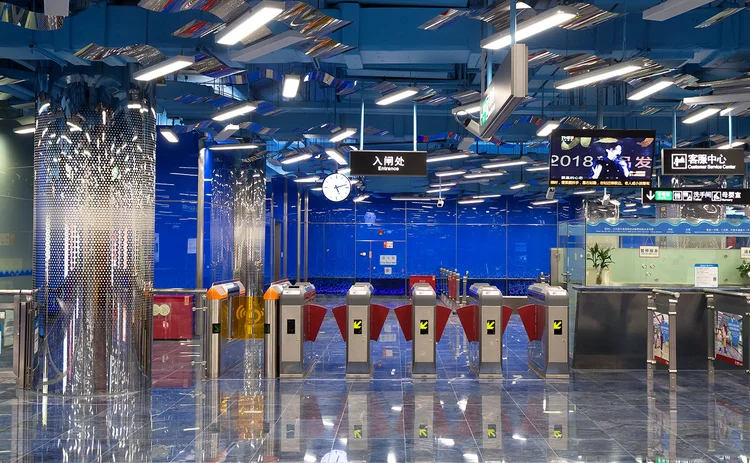
Accelerated development in Nansha


Compared with the other three bay areas – those of New York, San Francisco and Tokyo – the Guangdong–Hong Kong–Macao Greater Bay Area has the largest land area and population, along with world-class high-throughput airports and seaports. Economic growth in the Greater Bay Area was 7% in 2017, far outpacing the other bay areas, and it ranks third of the four economically.
The per capita GDP of the Greater Bay Area is, however, the lowest of the four bay areas, at a little more than US$20,000, whereas San Francisco’s bay area reaches around $100,000. Tertiary industry accounts for the lowest proportion in the Greater Bay Area, at around only 60%, with New York having the highest, at 89%.

The Greater Bay Area has the largest market capacity and the most complete industrial system of the four bay areas. The region covers nine cities in the Pearl River Delta and the two special administrative regions, Hong Kong and Macao, and radiates out to Guangdong and the entire south-east of China. This huge market potential is the mainstay of economic development here, and the Greater Bay Area should be fully confident in becoming the most economically active bay area in the world and a world-class city cluster.
Cities in the Greater Bay Area
Hong Kong, Macao, Guangzhou and Shenzhen are the four core cities, comprising the upper levels of a ‘1+3+7’ model. Hong Kong is at the first level, Macao, Guangzhou and Shenzhen at the second, and the other seven cities make up the third. Hong Kong is the international financial shipping trade centre; Guangzhou is the capital of Guangdong Province, the traditional millennium commercial city and now a thriving trade centre; and Shenzhen is emerging as a new force in science and technology innovation, with its economic aggregate surpassing that of Guangzhou in 2017. According to 2018 Globalization and World Cities Research Network data, Guangzhou ranks 27th among the world’s top international cities; Shenzhen ranks 58th. Hong Kong and Guangzhou are both classed as first-tier cities. In the financial index, Guangzhou ranks 19th, Hong Kong ranks third and Shenzhen ranks 10th. A comparison of these three cities reveals several particularly similar figures: total economic aggregate; growth rates (Shenzhen and Guangzhou are a little faster than Hong Kong); and the throughput of the airports and seaports. In 2018, Hong Kong handled more than 70 million airport passengers, Guangzhou 70 million, and Shenzhen more than 50 million. Shenzhen also has the highest container throughput.
The Nansha District, in the southernmost part of Guangzhou, has a unique geographical advantage at the geometric centre of the Greater Bay Area, with Hong Kong, Shenzhen and Dongguan to the east, Guangzhou and Foshan to the north, and Zhongshan, Jiangmen and Macao to the west. Nansha also has a distinct policy advantage as a national economic and technological development zone, a national new district and one of Guangdong’s three free-trade zones. The Nansha Free-Trade Zone covers an area of 60 square kilometres, which is larger than the other two zones combined.
Furthermore, it undertakes the mission of comprehensive co-operation of the Greater Bay Area. Hong Kong and Shenzhen are highly developed, but there is limited space for further development. Nansha has an area of 803 square kilometres, with the concentration of urban development now approaching 20%. Of the 60 square kilometres of the free-trade area, approximately 38 are awaiting development. Nansha is also optimising its living and business environments: it places great importance on convenient transportation, high-end medical education, resource agglomeration, and culture, sports and entertainment facilities. With the operation of the Guangzhou–Shenzhen–Hong Kong high-speed railway, Nansha is only 30 minutes from Hong Kong, and metro lines connecting it with downtown Guangzhou will come into service at the end of 2020. Nansha will form a half-hour traffic circle with Hong Kong, Shenzhen, Dongguan, downtown Guangzhou, Zhongshan, Zhuhai and Macao.
Education and healthcare
Hubs of advanced education and medical resources are expected to coalesce in Nansha. The Hong Kong University of Science and Technology has signed a framework agreement to set up a campus there, construction on which is expected to start in the first half of 2019. In addition, some of the best public education resources and international schools are situated in Nansha. In healthcare, Guangdong’s best hospitals, including the First Affiliated Hospital, Sun Yat-sen University; Guangdong Hospital of Traditional Chinese Medicine; Guangzhou Women and Children’s Hospital and Health Institute; Guangzhou First People’s Hospital, Sun Yat-sen University Cancer Centre; and the Affiliated Hospital of Stomatology, Sun Yat-sen University, are located in Nansha.
Nansha’s ecology is also outstanding. The average PM2.5 (the measurement of particulate matter in the air) in Nansha is 27 – which is moderate on the Air Quality Index. After two months of continuous monitoring, Nansha’s water quality was classified as grade II, meeting the drinking standard of tap water.
At the same time, the business environment is also strengthening. The Nansha Free-Trade Zone has set a benchmark for reform and innovation nationwide. For example, in the enterprise registration, the examination and approval of industrial and commercial business licences and tax invoices can now be completed within one working day, and all matters related to pre-business examination and approval must be completed within three working days, standards comparable to the most advanced countries in the world. The Administrative Committee of Guangzhou Nansha Development Zone is accountable for carrying out reform and the policy of ‘opening-up’.
Connectivity, complementarity and co-ordination
In a well-developed bay area, connectivity is paramount – particularly with regard to transport. In the Greater Bay Area, the construction of transport infrastructure is being accelerated. The opening of the Guangzhou–Shenzhen–Hong Kong high-speed rail link in September 2018 was a landmark. In October 2018, Guangdong held a discussion with Hong Kong chief executive Carrie Lam on the construction of rail transit in the inner bay area, to connect all nodes with the Hong Kong–Zhuhai–Macao bridge. Connectivity also includes the free flow of people and logistics, which has become far more rapid, and of capital and information, which still has a long way to go.
Each of the ‘9+2’ cities has its own advantages and characteristics. They should draw on each other’s strengths and develop each other in a unique way. Competition is the norm, but it should be orderly and co-ordinated.
Co-ordination refers to overall planning. Whether it is the bay areas of Tokyo, New York or San Francisco, the alliances between the three bay area cities play a very important role. The Greater Bay Area should, therefore, play the role of the central government, and provincial and municipal governments at all levels so we can work together to further accelerate development.
Only users who have a paid subscription or are part of a corporate subscription are able to print or copy content.
To access these options, along with all other subscription benefits, please contact info@centralbanking.com or view our subscription options here: subscriptions.centralbanking.com/subscribe
You are currently unable to print this content. Please contact info@centralbanking.com to find out more.
You are currently unable to copy this content. Please contact info@centralbanking.com to find out more.
Copyright Infopro Digital Limited. All rights reserved.
As outlined in our terms and conditions, https://www.infopro-digital.com/terms-and-conditions/subscriptions/ (point 2.4), printing is limited to a single copy.
If you would like to purchase additional rights please email info@centralbanking.com test test test
Copyright Infopro Digital Limited. All rights reserved.
You may share this content using our article tools. As outlined in our terms and conditions, https://www.infopro-digital.com/terms-and-conditions/subscriptions/ (clause 2.4), an Authorised User may only make one copy of the materials for their own personal use. You must also comply with the restrictions in clause 2.5.
If you would like to purchase additional rights please email info@centralbanking.com test test test







